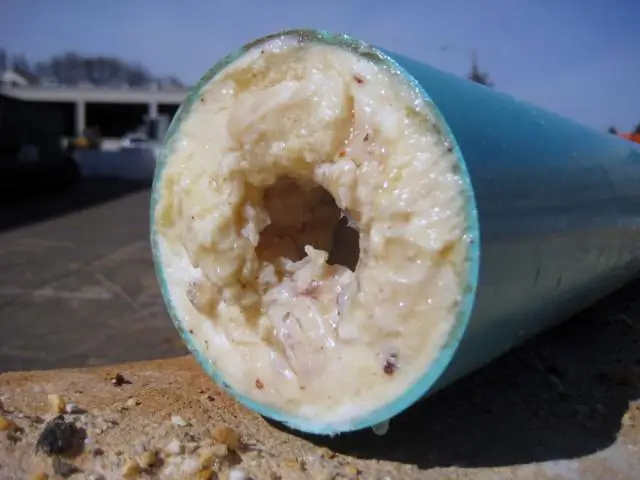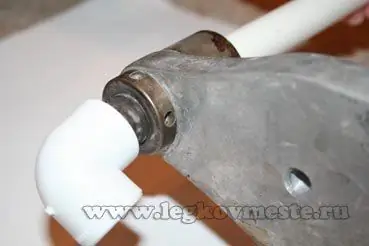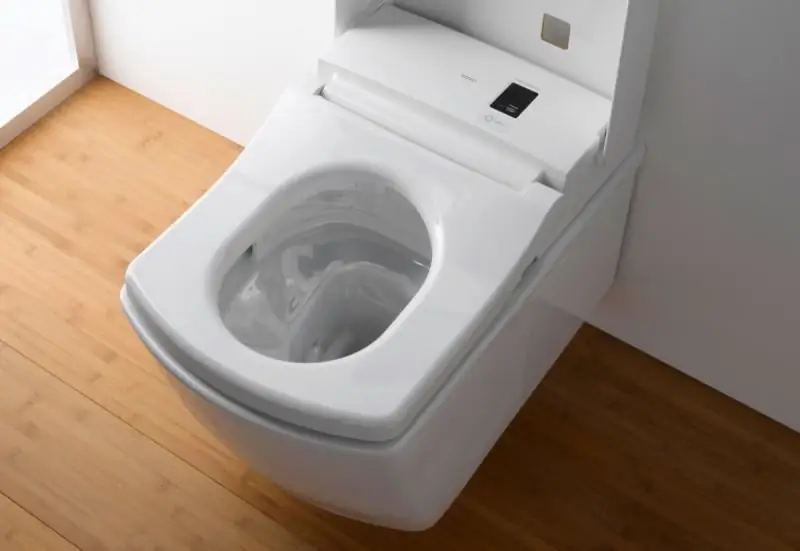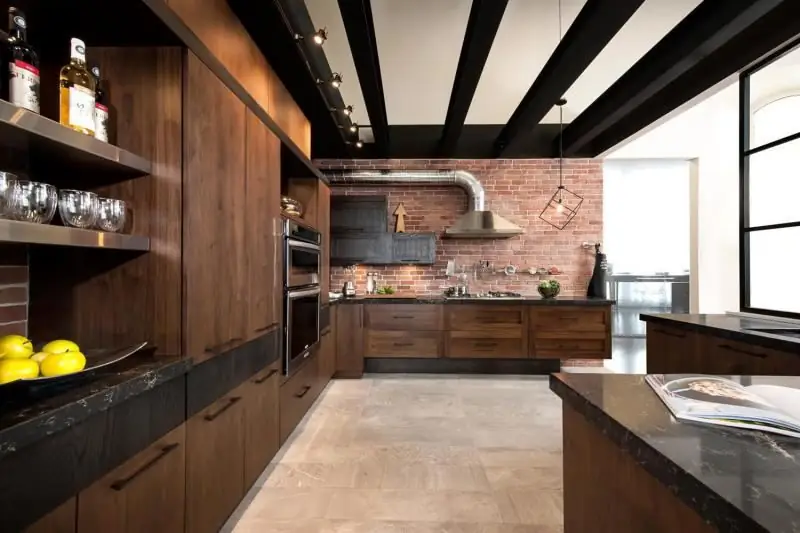
Table of contents:
- "By yourself with a mustache" we eliminate blockages in pipes at home
- Causes of blockages
- Start by unclogging a sink or sink drain
- How to determine that the plug is not in the siphon, but further in the pipe
- Mechanical ways to fix the problem at home
- Chemicals
- Folk ways
- How to clean a pipe through a drain in a bathtub, shower or toilet
- How to clean the siphon
- How to remove unpleasant odor from a drain
- The sewage system is clean, and the water does not go away: causes and solutions to the problem
- Prevention
- Author Bailey Albertson [email protected].
- Public 2023-12-17 12:53.
- Last modified 2025-06-01 07:32.
"By yourself with a mustache" we eliminate blockages in pipes at home

In the list of everyday difficulties, everyday troubles take not the last place. Clogged pipes at home are a common household problem. Fortunately, you can clean it without using a plumber. Moreover, it is not necessary to buy even special cleaning products right away - use to remove the cork first with what is in every house. The main conditions for success are calmness and having an hour or two of free time.
Content
- 1 Causes of blockages
- 2 Start by emptying a sink or sink
- 3 How to determine that the plug is not in the siphon, but further in the pipe
-
4 Mechanical remedies at home
- 4.1 Ventus
-
4.2 Plumbing cable
4.2.1 Video: how to clean the pipe to the central riser
- 4.3 Alternative to the rope - improvised means
-
5 Chemicals
5.1 Video: plunger or chemistry: how to unclog a blockage in pipes at home
-
6 Folk ways
- 6.1 Soda and vinegar
- 6.2 Vinegar and Alka-Seltzer
-
7 How to clean a pipe through a drain in a bathtub, shower or toilet
7.1 Video: how to quickly clean the bath
- 8 How to clean the siphon
- 9 How to eliminate unpleasant odor from the drain
- 10 The sewage system is clean, but the water does not go away: causes and solutions to the problem
- 11 Prevention
Causes of blockages
Water in pipes can stagnate for several reasons:
- Cast iron pipes are most often clogged due to the appearance of corrosive irregularities on the inner walls. Particularly often such raids are subject to the segment of the kitchen sink outlet before the bathroom outlet.
-
Plastic pipes are very often clogged due to improper installation of sewer equipment. The slightest violation of the angle of inclination in relation to the riser - and a blockage is provided.

Two-piece washbasin with blue trim and plunger in one section Especially often the sink in the kitchen gets clogged
There are also so-called universal reasons that do not depend on the pipe material:
- Grease and dirt, adhering to the inner walls, contribute to the fact that small debris clings to this plaque. A dense mass is gradually formed, which does not allow water to pass through.
- Limescale that settles on the pipe walls due to impurities that make up the water.
- Sand and dirt that gets into the sink or bathtub when washing shoes or pets.
- Foreign objects entering the sewer. You will have to call specialists who will help with hydraulic installations to cope with this problem (especially when it comes to a high-rise apartment building), or remove the item yourself.
- Detergents with surfactants (surfactants) that enhance the ability of water to wet physical bodies. That is, the substances that make up soaps, powders and gels for cleaning, etc. Surfactants act on the sewer in the same way as fat.
Thus, regardless of the material from which the sewer system is made, sooner or later everyone will have to face the obstruction of water in the pipes. This means that you need to arm yourself with the simplest (but at the same time effective!) Ways to solve the problem.
Start by unclogging a sink or sink drain
Most often, the drain in the kitchen or bathroom is clogged. It is there that there are a lot of fats and small debris (food debris, hair) for objective reasons. The sooner you start a "war" for the free passage of water, the better. And for starters, you should apply a simple four-step instruction:
- Boiling water. If the pipes are steel or cast iron, then about 1 liter of boiling water should be poured into them. If they are plastic, then it is enough to let the hot water flow from the tap in a small stream for 20 minutes. This is an ideal way to dissolve a bar of soap that has fallen into the drain.
- Soda and salt. Pour ½ tbsp into a glass of water. salt and 1 tbsp. soda, mix well and pour into the drain. After 10-15 minutes, clean with a plunger or a cloth folded into a dam.
- Vacuum cleaner. Quite an unusual step, but very effective. The only condition: the vacuum cleaner must have a blowing function. It is necessary to seal the vacuum cleaner pipe with a rag and insert it into the drain. When turned on, a strong air flow will push through the formed plug.
- Clean the siphon. To do this, remove it and, after cleaning it well from the inside, rinse it with running water.
If the steps taken did not help, then the cork is already too tight and needs to be treated differently.
How to determine that the plug is not in the siphon, but further in the pipe
Before proceeding with a deep cleaning, you need to make sure that the problem is not in the sink, toilet or bathtub, but in the pipe. To do this, we drain the water in the entire system and evaluate:
- water accumulates in several plumbing devices (for example, in a bathtub and a sink), which means that there is a general congestion localized at one of the plumbing connection points to the sewage system;
- water accumulates only in the sink (or in a bathtub, toilet bowl, sink) - then the blockage is local, which is easiest to deal with, since it is formed in siphons, a toilet bowl water seal and filters of household appliances (washing machines, dishwashers);
- the liquid stagnates in the entire sewer system - a global congestion that requires professional intervention.
You can solve the problem with local and general on your own. To do this, we disconnect the siphon, the corrugation of the sink, sinks, bathtubs and we are cleaning the drain holes of the sewer pipe. That is, we can pour a chemical agent into these holes, pour granules, but the main way is to clean it with a cable. And if there are no men's hands to empty the sinks and work with them, then we are trying to influence the problem with chemical and simple methods.

If there is a blockage in the pipes, then it is necessary to clean the drains of the sewer pipes, indicated in the diagram as taps
Mechanical ways to fix the problem at home
The task of this type of exposure is to break the plug into small parts, which can then be removed from the surface, or they themselves will be easily washed down the drain. Mechanical cleaning methods are especially effective in kitchens where food residues are the most common cause of plugging.
Ventuz
This is a kind of first aid for an amateur plumber, that is, each of us. The plunger is easy to use, and the hydraulic column, which is formed due to the vacuum effect.

A plunger is a necessary device for cleaning the drain, which should be in every home
Instructions:
- We collect water in the sink.
- We press the plunger to the drain and push.
- We make several forward movements, and with the last, strongest, we tear off the plunger from the drain hole. It is important to correctly calculate the force, otherwise you can damage the sink parts.
- Repeat 3-4 times if necessary.
Please note: if you have a two-piece sink in your kitchen, then it is better to get two plungers for both bowls. Moreover, the cleaning procedure must be carried out simultaneously (that is, you cannot do without an assistant). If there is no second plunger, then you can close the second drain with a rag, pressing it tightly against the hole.
Plumbing cable
A brush or spiral on a wire made of steel with a handle does an excellent job of deep cleaning of pipes.

Modern models of cables are equipped with a reel handle, but such spiral cleaning machines are expensive.
Instructions:
- Place the brush or spiral in the drain.
- We scroll the device, directing it either away from ourselves, down, or towards ourselves, pulling the plug out.
- From time to time we supply water to the sink so that the cork elements pass into the sewer.
Metal pipes are cleaned with a metal cable, and you can also get rid of rust from the inner walls. For plastic ones, a flexible twisted wire rope is used in a "cover" made of an elastic sheath, avoiding strong mechanical pressure.
Video: how to clean the pipe to the central riser
Alternative to the cable - improvised means
What if there is no cable in the house? Call on imagination and folk experience.

Convenient wire rope for cleaning sinks with narrow drain holes
Instructions:
- From top to bottom we glue the bottle with strips of scotch tape so that we get a spiral. Draw lines along the border of the adhesive tape with a marker.
- We cut the bottle along the outlined lines.
- We leave the bottom - it will be a handle.
- In a spiral, we make notches at an angle of 45 degrees.
-
We insert the cable into the drain and slowly pull it out by the “handle”: the debris that has accumulated in the pipe will cling to the “fringe” of the spiral.

A bottle with a spiral drawn around a circle Bottle rope can even be used for plastic pipes
Conclusion: of the mechanical methods for plastic pipes, only a flexible cable or a homemade cable from a plastic bottle is suitable
Chemicals
Household chemical manufacturers offer a wide range of special products:
- liquid (for example, "Tiret" (no ammonia odor), "Mister Muscle" (with the smell of ammonia) - they act gently on the material, but they remove the blockage effectively, especially in plastic);
- powders (for example, "Komet" - not always convenient to use, especially if the water does not come off at all);
- acidic (for example, "Mole");
- alkaline (for example, "Whiteness", "Domestos").
Despite the advertisements, these agents (especially alkaline and acidic) in practice should not be often used for cleaning plastic pipes. Moreover, on the Internet you can find thousands of "horror stories" about how "Mole" ate a pipe. Of course, a lot depends on the quality of the plastic, but nevertheless, the use of chemicals more than 1 time per month is not recommended.

There are pipe cleaners in the product lines of all major manufacturers of household chemicals
Chemicals should be used according to the instructions on the package. Usually, the scheme is as follows: the substance is poured (poured), left for a while and washed off with water. For example, before using "Mole", boiling water should be put into the drain, and after the end of the action, rinse the drain with a cold stream.
Video: plunger or chemistry: how to clear a blockage in pipes at home
Folk ways
You can also clean the pipes with means that have been checked more than once.
Soda and vinegar
Instructions:
- We put soda in the drain and pour vinegar in a 1: 1 ratio (for the first time, you can take ½ tbsp.).
- We close the hole with a stopper.
- After 5-7 minutes, rinse the drain with a small pressure of hot water.

Soda and vinegar are the most famous folk remedies for cleaning plums.
Vinegar and Alka-Seltzer
If there is no soda in the house, but there is a hangover cure, then they perfectly replace each other. True, only for cleaning the drain.
Instructions:
- Throw 2 tablets of Alka-Seltzer into the drain.
- Fill in 1 tbsp. vinegar.
- After 5 minutes, rinse with high pressure of hot water.

Hangover remedy is a great substitute for baking soda
How to clean a pipe through a drain in a bathtub, shower or toilet
To eliminate the plug in the drain pipes of the bathroom or in the toilet, you can use all the above folk methods (with the same restrictions). But using the cable in the toilet will not work. The wire will simply run down the riser.

For a toilet, the easiest way is to use a plunger, however, it is important to choose a suitable bowl diameter
If we are talking about a shower or a bathtub, then it is recommended to begin with trying to rinse the drain with a shower hose.
Instructions:
- Remove the watering can and the rubber seal from the shower hose.
- We put a watering can on one of the drain holes and let a strong pressure of water (preferably hot).
- We wash for 5-10 minutes. If water flows out of other drain holes, cover them with a cloth.
- We repeat the procedure with all the drain holes.
Video: how to quickly clean a bath
How to clean the siphon
If the blockage is local, then most often it is located in the siphon.

Do not forget to substitute the container before unscrewing the siphon
Instructions:
- We unscrew the plastic nut that holds the tube in the drain siphon.
- We pull out the siphon and lower it into a basin for further cleaning (we remove all the dirt with a hand or a brush).
- Pour a soda-vinegar mixture into the pipe connected to the sewer (as described above).
- After the end of the reaction, pour in a glass of vinegar.
- Repeat the addition of vinegar until the hissing stops.
- After 15-20 minutes, pour 2-3 liters of hot water into the pipe (not boiling water!).
- We fasten the siphon in place, tighten the plastic nut.
Steps 3-6 are necessary if there is a plug in the pipe. If cleaning the siphon is a regular event not caused by water obstruction, then you do not need to use a soda-vinegar mixture.
How to remove unpleasant odor from a drain
It is logical that to eliminate the smell, you need to remove the cork - the reason for the spread of bacteria that provoke disgusting amber.
In this case, some simple tricks will help:
- Pour dry mustard into the drain, fill it with hot water, leave for 10 minutes and rinse.
- A liquid bleach solution will also effectively eliminate the smell, however, it will interrupt it with its own - not pleasant for everyone.
- Air fresheners are a quick way to kill the unpleasant smell from the drain, however, the problem will be solved only in literally a few hours.

The blockage is usually accompanied by an unpleasant smell from the drain
Sometimes the cause of an unpleasant odor from the drain can be the absence of a water seal - a kind of water lock that prevents odor from escaping from the sewer into the apartment. A water seal in the sewerage system is provided by a siphon. Improper installation of the latter can cause odors to enter rooms.
The solution to the problem depends on the type of siphon:
- If the siphon is bottle-type, then it is necessary to adjust the location of the drain pipe so that it is two to three centimeters below the water level. Otherwise, the vapors will pass over the waterlock.
- If the siphon is pipe, then perhaps the drain pipe for some reason straightened or was initially installed incorrectly. In this case, you just need to give it the desired shape to ensure the formation of a normal water seal and fix it in this position with special clips.
The sewage system is clean, and the water does not go away: causes and solutions to the problem
Stagnant water is not always the result of a clogged drain hole. Sometimes the reason is:
- in a clogged siphon (often after repair work, the remains of construction debris get there);
- in the wrong bend of the corrugation, which goes from the siphon to the sewage system (if the siphon is of a bottle type, then there must be a side outlet and an elongated lower part for the accumulation of water; if the siphon is pipe, then one of the pipes of the system must have a curved shape);
- plugs at the joints of silicone pipes, with which these same joints were processed.
You can solve the problem by eliminating the root cause:
- clean the siphon;
- check that the bend of the corrugation corresponds to the type of siphon;
- remove the silicone plug (gently clean it with sandpaper or the blunt side of a knife).
Prevention
To prevent the drain from clogging up thoroughly, it is necessary to carry out preventive work in a timely manner (mainly they relate to prevention in the kitchen).

The easiest way to prevent blockage is to let boiling water into the pipes every day.
And also follow the recommendations of plumbers:
- do not pour fatty liquids into the sink in the kitchen;
- Throw the remains of food from the dishes into the trash bin before washing;
- to protect against the ingress of small food residues or hair on the drain, it is necessary to put a special protective mesh;
- do not throw hair from the comb into the sink or toilet;
- pour boiling water over the drain hole every day.
You can remove the blockage in the pipes yourself. The main thing is to find the right methods. These are both mechanical cleaning options and chemical ones - to deal with old corks. Folk tricks will help with small traffic jams. But there is nothing better than timely prevention. And then you don't have to become an amateur plumber too often.
Recommended:
How To Clean A Gas Stove (grate, Burners, Pens, Etc.) With Folk Remedies (soda, Ammonia) And Not Only

Practical advice on cleaning a gas stove from grease and dirt. Folk remedies for cleaning surfaces, handles, burners and oven
Joining Of Plastic Pipes By Welding - Installation Of Plastic Pipes Using A Welding Machine

Welding plastic pipes with your own hands. Replacing the plumbing in the bathroom and kitchen with your own hands using a plastic pipe welding machine
How To Clean The Toilet From Urinary Stones At Home, How Can You Remove Plaque Inside (including Using Folk Remedies)

Where urinary calculus forms, the most effective ways to clean it from the toilet at home, photos, videos and tips for preventing the formation of growths
Baby Heels: How To Clean At Home, Including Folk Remedies

How to exfoliate your feet. Professional, folk and mechanical methods. What can not be treated with feet
How To Hide Or Decorate Pipes In The Kitchen During Repairs (gas, Ventilation, Sewer): Tips And Photos

What is the best way to hide pipes for heating, gas, water supply. Ideas and implementation. What is desirable and what is unacceptable. How to decorate pipes beautifully and safely
